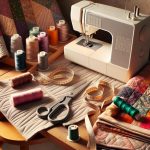Are you looking to create a cozy and stylish accessory?
In this article, we’ll show you how to make a scarf out of cotton fabric. With just a few materials and tools, you’ll be able to craft a fashionable and functional scarf that suits your personal style.
Whether you’re a seasoned crafter or a beginner, our step-by-step instructions will guide you through the process.
So, grab your fabric and let’s get started on making your own unique cotton scarf.
Table of Contents
Selecting the Right Cotton Fabric
When selecting the right cotton fabric, it’s important to consider the texture and weight. Cotton fabric comes in various types such as plain weave, twill, and satin. Each type has its own unique characteristics and uses.
Plain weave cotton fabric is lightweight and breathable, making it ideal for summer clothing.
Twill cotton fabric has a diagonal pattern and is known for its durability, making it suitable for heavy-duty clothing like jeans.
Satin cotton fabric has a smooth and shiny finish, making it perfect for elegant and luxurious garments.
One of the benefits of cotton fabric is its breathability. Cotton is a natural fiber that allows air to circulate, keeping you cool and comfortable in hot weather. Additionally, cotton fabric is hypoallergenic and gentle on the skin, making it suitable for people with sensitive skin or allergies. Cotton fabric is also highly absorbent, making it a great choice for towels and bathrobes.
When selecting cotton fabric, consider the weight that suits your project. Lightweight cotton fabric is suitable for garments like dresses and blouses, while heavyweight cotton fabric is ideal for items like jackets and upholstery.
Gathering the Necessary Materials and Tools
When it comes to making a scarf, there are a few essential materials you’ll need.
First and foremost, you’ll need the right fabric, such as cotton or wool, depending on your preference.
Additionally, having the right tools, such as scissors, sewing needles, and a measuring tape, is crucial for a successful scarf-making project.
Essential Materials for Scarf
To make a scarf out of cotton fabric, you’ll need a pair of fabric scissors. But before you start cutting, there are a few things to consider.
First, you need to choose the right fabric for your scarf. Cotton is a great choice because it is soft, breathable, and easy to work with.
Next, think about the length of your scarf. Do you want it to be short and stylish or long and cozy? The length will determine how much fabric you need.
Once you have your fabric and know the desired length, it’s time to cut. Use the fabric scissors to trim the fabric into a rectangular shape.
And just like that, you’re one step closer to creating your own cotton scarf.
Choosing the Right Tools
The right tools for this project include a pair of fabric scissors. When choosing fabric for your scarf, consider the weight, texture, and color. Lightweight cotton is a popular choice for scarves as it is breathable and comfortable to wear.
To begin, use fabric scissors to cut a rectangular piece of fabric to your desired size. Other tools you may need are sewing pins, a sewing machine or needle and thread, and an iron. Sewing pins will help you secure the fabric in place before sewing. A sewing machine or needle and thread will be used to stitch the fabric together. Finally, use an iron to press the seams and give your scarf a polished finish.
With the right tools, you’ll be able to create a beautiful cotton scarf in no time.
Measuring and Cutting the Fabric
First, measure and cut the fabric according to your desired length and width. To ensure accuracy and precision, here are some measuring techniques and cutting tips to follow:
- Use a measuring tape or ruler to measure the fabric. Ensure that it is flat and taut to get accurate measurements.
- Double-check your measurements before cutting to avoid any mistakes. Measure twice, cut once.
- Use sharp fabric scissors to ensure clean and neat cuts. Dull scissors can result in jagged edges.
- Consider using fabric weights or pins to hold the fabric in place while cutting. This will prevent shifting and ensure straight cuts.
- If you’re unsure about the measurements, it’s always better to cut the fabric slightly longer than desired. You can always trim it later if needed.
Sewing the Edges of the Scarf
Once you have finished measuring and cutting the fabric, start sewing the edges of the scarf using a running stitch. This stitching technique is perfect for securing the edges and giving your scarf a neat finish.
To begin, thread your needle with a matching thread and tie a knot at the end. Place the fabric right sides together and align the edges. Starting from one corner, insert the needle through both layers of fabric and pull it through. Repeat this step, making small, even stitches along the edge. Ensure that the stitches are close together to prevent fraying.
As you sew, keep the tension even and the stitches straight. Take your time to achieve a professional-looking result. Once you reach the corner, make a small knot to secure the thread. Continue sewing the remaining edges of the scarf in the same manner.
When you reach the starting point, tie another knot and trim any excess thread. Congratulations! You have successfully sewn the edges of your scarf using a running stitch.
Now, it’s time for the finishing touches!
Adding Embellishments or Decorative Elements
Now that you’ve sewn the edges of your cotton fabric scarf, it’s time to add some decorative elements to make it truly unique. Adding embellishments such as decorative embroidery or beading techniques can take your scarf to the next level.
Here are some ideas to inspire you:
-
Embroidery: Use colorful threads to create intricate patterns or designs on your scarf. You can try different stitching techniques like cross-stitch, satin stitch, or chain stitch to add texture and visual interest.
-
Beaded Accents: Sewing on beads can instantly elevate the look of your scarf. You can choose beads in various shapes, sizes, and colors to create patterns or simply scatter them randomly for a whimsical effect.
-
Fringe: Adding fringe to the ends of your scarf can give it a bohemian or retro vibe. You can use matching or contrasting fabric to create fringe strips and attach them to the edges.
-
Pom-Poms: Sewing on colorful pom-poms can add a fun and playful touch to your scarf. You can either buy ready-made pom-poms or make your own using yarn.
-
Sequins: If you want to add some sparkle to your scarf, sewing on sequins can do the trick. You can create patterns or arrange them in a random manner for a glamorous look.
Get creative and experiment with different techniques to make your cotton fabric scarf truly stand out!
Creating Fringed or Tasseled Ends
If you want to add a stylish touch to your scarf, consider styling it with tassel ends. Tassel ends can add a playful and bohemian vibe to your scarf, and they are easy to make.
In this discussion, we will explore the difference between fringe and tassels, and how you can use them to enhance your scarf’s look.
Styling With Tassel Ends
To style your scarf with tassel ends, simply choose a length of cotton fabric and attach tassels to each end. The placement of the tassels can greatly affect the overall look of your scarf. Consider placing the tassels symmetrically, with one tassel at each end. Alternatively, you can place them asymmetrically, with more tassels on one end for a unique and playful look.
When choosing tassel colors, opt for complementary or contrasting shades to add visual interest. You can also match the tassel colors to your outfit for a coordinated look. Experiment with different tassel lengths and textures to create a scarf that reflects your personal style.
Have fun and get creative with your tassel placement and colors!
Fringe Vs Tassel
When choosing between fringe and tassel, consider the overall style you want to achieve. Fringe adds a bohemian and relaxed vibe to your scarf, while tassels give a more polished and sophisticated look.
Fringe is made by cutting strips of fabric and attaching them to the ends of the scarf, creating a playful and textured effect.
Tassels, on the other hand, are made by knotting threads or cords and attaching them to the ends of the scarf. They can be simple or adorned with beads for added elegance.
Ironing and Pressing the Finished Scarf
After you’ve finished sewing the edges, go ahead and iron the scarf to give it a smooth and polished look. Ironing is an essential step in the process of making a scarf, as it helps to remove wrinkles and creases, and gives the fabric a professional finish.
Here are some ironing techniques and fabric care tips to keep in mind:
- Set the iron to the appropriate temperature for your fabric. Cotton typically requires a medium to high heat setting.
- Use steam to help relax the fibers and remove stubborn wrinkles. Hold the iron a few inches above the fabric and press the steam button.
- Iron in a back and forth motion, applying gentle pressure. Avoid dragging the iron across the fabric, as this can stretch or distort the fibers.
- Pay extra attention to the edges and corners of the scarf to ensure they are properly pressed.
- Always iron the scarf on the wrong side of the fabric to prevent any potential damage to the design or color.
Styling and Wearing Your Cotton Fabric Scarf
You can easily style and wear your cotton fabric scarf in various ways to add a fashionable touch to your outfits. Cotton fabric scarves are versatile accessories that can complement any look. Here are some styling tips and different ways to wear a cotton fabric scarf.
Firstly, you can wear your cotton fabric scarf as a traditional neck scarf. Simply drape it around your neck and let the ends hang loose or tie them in a knot for a more polished look. This classic style works well with both casual and formal outfits.
Another way to wear a cotton fabric scarf is as a headband. Fold the scarf into a thin strip and tie it around your head, either at the top or as a headband. This adds a playful and bohemian touch to your hairstyle.
For a trendy twist, you can also wear your cotton fabric scarf as a belt. Loop it through the belt loops of your jeans or trousers, or use it to cinch in the waist of a dress or tunic. This adds a pop of color and texture to your outfit.
Lastly, you can get creative and wear your cotton fabric scarf as a beach cover-up. Simply wrap it around your waist or chest and tie it in a knot to create a stylish sarong or halter top. This is perfect for beach days or poolside lounging.
Conclusion
So there you have it – a simple and straightforward guide on how to make a scarf out of cotton fabric.
By following these steps, you can create your own stylish and comfortable scarf that can be worn in any season.
Remember to choose the right cotton fabric, measure and cut accurately, sew the edges securely, and add any desired embellishments.
With a little creativity and effort, you can make a unique and fashionable cotton fabric scarf that will be a great addition to your wardrobe.
Happy crafting!
- Does Lyocell Breathe? An In-Depth Look at Its Breathability - July 14, 2025
- Can You Steam Lyocell? The Best Way to De-Wrinkle Your Garments - July 14, 2025
- Is Lyocell Toxic? A Look at the Safety of This Eco-Friendly Fabric - July 14, 2025




